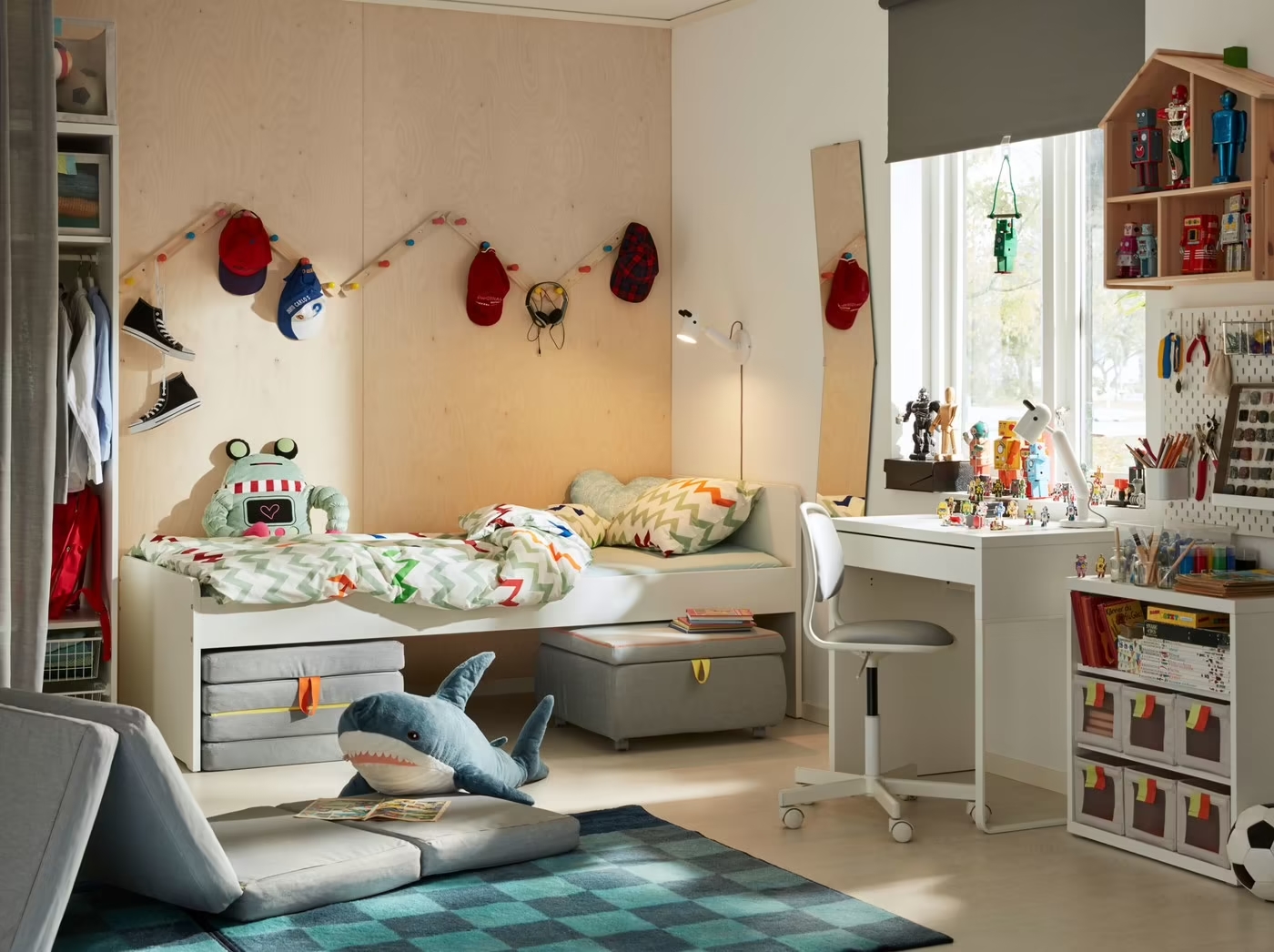My decision to prioritize my son’s bedroom over the leaking roof, rotting floors, and broken chimneys when we first moved into our questionably habitable wreck of a house wasn’t motivated by mother responsibility. Instead, it was because the room had lime-green woodwork, a grey faux-brick feature wall, Banksy stencils around the fireplace, and an absolutely goofy industrial-effect overhead light, and I was frightened that my then ten-year-old son would want to keep it all.
He described the light as “steam-punk, and incredibly fantastic,” and he wanted an optical illusion rug that made it appear as though stepping on it would cause you to fall into a huge hole. These statements led me to conclude that he was afraid of falling. I don’t dispute that the outfit would have been powerful, but it isn’t my style. (In addition to everything else, I have vertigo; without that rug, I wouldn’t have been able to enter Sholto’s chamber. Now that I’m writing this, I see that it may have been the point.)
The importance of properly decorating children’s classrooms was discussed by Edith Wharton in The Decoration of Houses. She noted that “daily intercourse with poor pictures, trashy “ornaments,” and badly designed furniture may, in fact, be fittingly compared with a mental diet of silly and ungrammatical storybooks.” Well, her readers in the 19th century did not have to deal with TikTok and MTV Cribs, or perhaps more importantly, social media demands among their children’s peer group. Because of how challenging the tween and adolescent years are, there is frequently a timid relaxing of the apron strings, along with urges to fit in and, on the other hand, to stand out. While on one side you want to give your kids some autonomy, frequent redecorating is neither sustainable nor feasible, and on the other hand, you probably want to be able to leave their bedroom door open without the design clashing with the rest of the house.
Cleverly approached, “designing with your child is an opportunity for them to learn about the reality of decorating, which can only happen through experience,” advises Lucy Hammond Giles of Sibyl Colefax & John Fowler. Include kids, if they’re interested, and they’ll learn the costs associated with decorating as well as the difference between the effect of a little swatch and full curtains in a particular design. What lessons can we learn from others who have already done it?
1. Pre-select and minimize the options
The secret, according to Lucy, “is to treat your children like a client,” and perform the laborious research for them. “You must give them options because everyone values choice, but you must limit them because otherwise it will be overwhelming.” The late, great John Fowler reportedly had a cunning way of making sure that the final decision was his; Adrian Tinniswood recalls him setting out several patterns and saying, “I expect you to think that blue is too pale,” then, “I’m sure you to think that blue is not right for the date,” before clasping a third and saying, “And you, darling you, with your unerring eye, will say this one is perfect.
2. Don’t be afraid to take ultimate responsibility
Because in the end, we do know better, Lucy explains that there are instances when you do need to convince people to go along with what you want. And we’re not trying to be condescending; rather, we want to guarantee beauty. The reason for Alexandra’s inducement is because “he does adore the wallpaper today, and acknowledges that it works very well with the blind, which is in Volga Linen’s Alyosha,” she claims. “He’s a very tidy youngster, and he believed that the overall effect wouldn’t work; now that it’s up he likes the neatness of the uniformity.”
3. Although: compromise
But a compromise is also necessary. Instead of black, Lulu’s son chose dark grey walls, but she nevertheless gave in to his demand for “something from Ikea” by building him a sizable closet, for which “I’m now creating curtains,” she says. The built-in shelves that her son had requested were happily given by Alexandra, while her daughter received the blue cabinet and bunk bed that she had been longing for.
And I should have had more faith in my son’s taste because he began removing the faux-brick wallpaper before I did. He also requested that his bedroom be painted the exact same shade of blue as in our previous home (Edward Bulmer Paint in Fair Blue), and I found a vintage headboard with a matching valance that isn’t particularly masculine but he hasn’t objected. In exchange, I helped him buy a futuristic floating light that he believes is cooler than the purportedly steampunk above light that I had to remove because I couldn’t bear to look at it.
4. Theming is not impossible
No one is arguing that a temple dedicated to the popular video game Fortnite will be appealing (gaming chairs are huge and incredibly awkward), but some theming can work if it is done nicely. I still have a slight covetousness over a Pierre Frey wallpaper with ponies that I first saw when I was eight years old. Then, I saw how Salvesen Graham used camouflage on storage stools, valances, and headboards in a boy’s bedroom. According to Nicole Salvesen, “The brief called for something highly durable; this clearly fit his personality and was a firm favorite when he was given some possibilities to look at.
5. Leave room for experimentation
In essence, we’re trying to control the chaos, adds Lucy, who estimates that she rearranged her furniture nearly every week as a child. “We’re offering them a structure within which they can experiment.” She proposes using large pinboards to help in the fight against blue-tack residue and including the kids in tasks like picture hanging (Alexandra has given her kids some pretty smart ones by Benedict Foley).
(My own daughter, who clearly believes strongly in trying new things, has organized three re-hangs of her bedroom in the past 18 months. She will soon need to acquire the life skill of filling in the gaps she is leaving, which I think is very important.)
6. Give them opportunity to discover their style
The odd indulgence may fall under this flexibility to try new things. Olivine Design’s Victoria Gray suggests giving kids £5 to spend at vintage markets and seeing what they come up with. Sholto returned with a plastic chandelier and a set of fake bull’s horns with Chinese characters, so I won’t pretend that my first attempt at implementing this policy was a success. However, it did start a discussion about materiality and use, and more recently, he spent some of the money he had saved on a rather lovely mid-century painting that now hangs above his bed. He also saved up to have it professionally framed. A vintage Mac desktop computer that Alexandra’s son, who is very interested in coding, purchased for himself “looks wonderful in his room with his modernist lamp,”
Later this month, when the new season of Interior Design Masters, one of my daughter’s favorite shows (we watch it together), premieres, I frequently catch her flipping through the copies of House & Garden I keep on the coffee table. Sarah Vanrenen credits a childhood spent “driving to site visits, interior projects, fabric and antique shops” with inspiring her to follow in her mother Penny Morrison’s footsteps and enter the interior design field. She loves to go with me to the framer (though she does have an opinion – which is sometimes useful).




